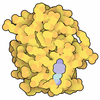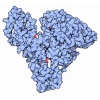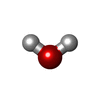Entry Database : PDB / ID : 9ecfTitle Crystal structure of the hERbeta LBD complexed with androstenediol and SRC 2-2 peptide (crystal form 2) Estrogen receptor beta Nuclear receptor coactivator 2 Keywords / / Function / homology Function Domain/homology Component
/ / / / / / / / / / / / / / / / / / / / / / / / / / / / / / / / / / / / / / / / / / / / / / / / / / / / / / / / / / / / / / / / / / / / / / / / / / / / / / / / / / / / / / / / / / / / / / / / / / / / / / / / / / / / / / / / / / / / / / / / / / / / / / / / / / / / / / / / / / Biological species Homo sapiens (human)Method / / / Resolution : 2 Å Authors Pederick, J.L. / Bruning, J.B. Funding support Organization Grant number Country Australian Research Council (ARC) DP230100609
Journal : To Be Published Title : Crystal structure of the hERbeta LBD complexed with androstenediol and SRC 2-2 peptideAuthors : Pederick, J.L. / Bruning, J.B. History Deposition Nov 14, 2024 Deposition site / Processing site Revision 1.0 Nov 19, 2025 Provider / Type
 Yorodumi
Yorodumi Open data
Open data Basic information
Basic information Components
Components Keywords
Keywords Function and homology information
Function and homology information Homo sapiens (human)
Homo sapiens (human) X-RAY DIFFRACTION /
X-RAY DIFFRACTION /  SYNCHROTRON /
SYNCHROTRON /  MOLECULAR REPLACEMENT / Resolution: 2 Å
MOLECULAR REPLACEMENT / Resolution: 2 Å  Authors
Authors Australia, 1items
Australia, 1items  Citation
Citation Journal: To Be Published
Journal: To Be Published Structure visualization
Structure visualization Molmil
Molmil Jmol/JSmol
Jmol/JSmol Downloads & links
Downloads & links Download
Download 9ecf.cif.gz
9ecf.cif.gz PDBx/mmCIF format
PDBx/mmCIF format pdb9ecf.ent.gz
pdb9ecf.ent.gz PDB format
PDB format 9ecf.json.gz
9ecf.json.gz PDBx/mmJSON format
PDBx/mmJSON format Other downloads
Other downloads 9ecf_validation.pdf.gz
9ecf_validation.pdf.gz wwPDB validaton report
wwPDB validaton report 9ecf_full_validation.pdf.gz
9ecf_full_validation.pdf.gz 9ecf_validation.xml.gz
9ecf_validation.xml.gz 9ecf_validation.cif.gz
9ecf_validation.cif.gz https://data.pdbj.org/pub/pdb/validation_reports/ec/9ecf
https://data.pdbj.org/pub/pdb/validation_reports/ec/9ecf ftp://data.pdbj.org/pub/pdb/validation_reports/ec/9ecf
ftp://data.pdbj.org/pub/pdb/validation_reports/ec/9ecf F&H Search
F&H Search Links
Links Assembly
Assembly




 Components
Components Homo sapiens (human) / Gene: ESR2, ESTRB, NR3A2 / Production host:
Homo sapiens (human) / Gene: ESR2, ESTRB, NR3A2 / Production host: 
 Homo sapiens (human) / References: UniProt: Q15596
Homo sapiens (human) / References: UniProt: Q15596 X-RAY DIFFRACTION / Number of used crystals: 1
X-RAY DIFFRACTION / Number of used crystals: 1  Sample preparation
Sample preparation SYNCHROTRON / Site:
SYNCHROTRON / Site:  Australian Synchrotron
Australian Synchrotron  / Beamline: MX1 / Wavelength: 0.9537 Å
/ Beamline: MX1 / Wavelength: 0.9537 Å Processing
Processing MOLECULAR REPLACEMENT / Resolution: 2→38.97 Å / SU ML: 0.31 / Cross valid method: FREE R-VALUE / σ(F): 1.34 / Phase error: 30.46 / Stereochemistry target values: ML
MOLECULAR REPLACEMENT / Resolution: 2→38.97 Å / SU ML: 0.31 / Cross valid method: FREE R-VALUE / σ(F): 1.34 / Phase error: 30.46 / Stereochemistry target values: ML Movie
Movie Controller
Controller




 PDBj
PDBj













